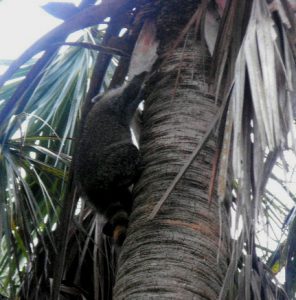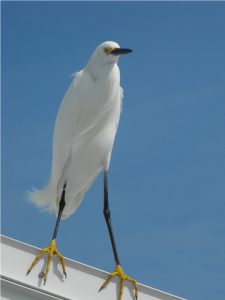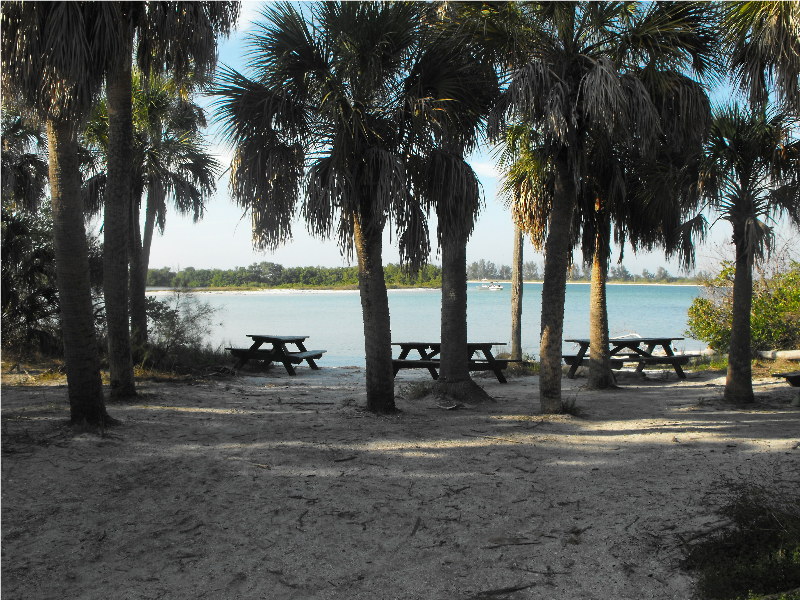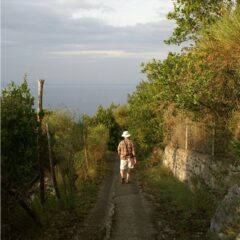We’ve previously posted articles about backpacking on Cumberland Island, but this post is for those of you who are looking for a great beach campground for car campers. You’ll find it at Fort De Soto Park near Tampa, Florida. According to one of the Rangers we spoke to at the campground, twenty-five years ago Tampa Bay was a polluted mess and the area around Mullet Key on which Fort De Soto is located had brackish backwater that couldn’t circulate and a dying grassy area in the bay that soured and smelled, particularly in the summer months. Cooperation between local, state, and federal agencies and the local conservation groups cleaned up the bay, cut new channels for water flow through and around Mullet Key and today the area is a haven for campers.
The island is reachable by a bridge from the Bayway or by water, but what will strike you is the fact that it has remained largely undeveloped.

If you look at the background in the picture above you will see the stretch of beach running from the Bay Pier up to North Beach. Note that there is not a single highrise nor even a house on the beach. If you go south from this point, you’ll enter the Bay pass the Bay pier and reach the tip of the island passing only the Park Headquarters building, restrooms and park concessions. That is to say, other than the buildings necessary to provide services to the visitors, there are no other buildings on this island. As you skid through Tampa on I-275, you will not believe you are going to a place as tranquil as this.
Fort De Soto Park Campground sits directly adjacent Anderson Boulevard, so it cannot be missed in terms of passing it by, but it might be missed in terms of getting a reservation. Reservations are taken 6 months in advance, unless you are a Pinellas County resident in which case you get an extra month. The campground holds back 10% of its 250 campsites for walk-ins. On the weekend, a walk-in can reserve a campsite for two nights. We asked the Ranger at check in about this and when one should arrive to be certain of a campsite. He said that the Ranger office opens at 7 a.m. , but that walk-ins would often arrive as early as 1:30 a.m. and bring their lawn chairs to sit outside the door. We checked this story out and on the Friday morning we were there, a person arriving at 2:00 a.m. would have been 5th in line!
The campground is laid out in three sections, a pet area for those camping pet owners who bring their pets along on their adventures and two other area’s across a short bridge over a man-made channel. The area to the right is primarily for RV‘s and large trailers while the area to the left is primarily for tents and smaller trailers. Campsites 1 to 85 are in this area, campsites 86 to 164 are in the pet area and campsites 165 yo 233 are in the larger RV area.

We’ve camped in campsites 1 and 20 which are both on the water facing out to the bay. As you can see from the picture above the campsites are laid out on a shell base to show you the area in which you should pitch your tent or park your RV. What you can’t see in this picture is that each has electrical service and water service, a grill, a picnic table, potable running water at a tap, and a hook on which to hang your lantern. A small camp store with a spacious deck for relaxation has most of the supplies you might need, if you don’t want to venture back into town. Each spacious campsite is separated from the adjacent campsites by a border of palmetto bushes and palm trees so each has a sense of privacy. However, if you are not in the pet area you will have visitors.

It is no surprise to see raccoons in the day or night, so be sure your food is properly stowed and your trash is properly disposed of in the receptacles provided. The weighted lids are more than a raccoon can lift to get into the bins, and these are not little raccoons. The ones strolling through our campsite would easily have weighted 15 pounds. You’ll also be visited by squirrels and birds, but clearly the largest and boldest of the visitors will be the ring-tailed bandits. As you can see at the right, they are easily frightened and will scurry away or climb a tree as soon as you get near, however, if you are not around they will go through everything you have that’s not tied down.
Campsites 1 to 48, 138 to 153, and 202 to 232 are all on the water facing generally to the west, although many of these have a hedge of bushes between them and the water, however, a large grassy border extends from the campsites to the water. It makes a great spot to set up your lawn chair late in the afternoon and watch the sunset.

In the picture above, you see the sun setting over the other end of the island, which is L shaped, so on the other side of the trees, the sun is settling into the Gulf fo Mexico just beyond the beach.
As mentioned above, there are no developments on the beach. However, Fort De Soto was built in the early years after the Spanish-American war between 1900 and 1910 and remains substantially intact. The fort was rendered obsolete by the development of mobile modern artillery and so the military closed it between WWI and WWII. None of the governmental entities nor developers had any interest in the island in the 40’s and 50’s and the island was largely managed as a bird sanctuary.

Today, thousands of birds can been seen and are still protected on the island, therefore, a large part of the island is off-limits as a nesting area, however, the undeveloped beach is therefore somewhat secluded from the central road and bike path and relatively unspoiled. The beach is widest and most usable from the Gulf pier (fishing is free with no permit required) up to the bird sanctuary at North Beach and above North Beach to the tip of the island. The beach extends southward beyond the fort and around the bend in the island past the Bay pier to east beach. At East Beach and North Beach, parking, pavilions and bath houses are supplied in abundance and are well maintained and clean. The cycling trail runs the length of the island and connects to a multiuse trail that runs along South Pinellas Bayway for several miles. You can pedal your hybrid or cruise bike along the path for miles without seeing a hill. The road cyclist zoom past in their spandex on the road, generally disdaining the multiuse path and its slower traffic.
The island and the campground make up one of the better family camping locales on any beach anywhere. It’s also quite attractive to the RV crowd. Camp cleanliness and light maintenance is the responsibility of about 8 couples who serve as camp hosts. They get their campsite free of charge for three months in exchange for 20 hours per week (per person) spent “doing the chores” that are necessary to keep the camp pristine. A husband and wife team, who were one of the host couples we spoke with, had been on the waiting list to host at Fort De Soto for three years and were thrilled to have finally arrived for their three month stay. The Rangers we talked to had all been with the park for at least a dozen years and many of the campers had returned for year after year to the park. One Pinellas county resident shows up at 2 a.m. on Friday nearly every week to get a walk in campsite so he can spend his weekend fishing and communing with nature.

Separate from the campground, on the north end of the island across from the pavilions and bath houses servicing north beach, a narrow road leads to Arrowhead picnic area. Again, the seclusion and sense of being out in a wilderness is amazing. The area is as well kept as the remainder of the park with trash cans, bath houses, and picnic tables available for day users. No overnight camping is allowed in this areas. You may want to just go sit there and rest by the water, or maybe you’ll rent a kayak and paddle up to here on your way to adjacent Shell island, which is also undeveloped and reachable only by boat. Either way you’ll find it a tranquil and restful spot.
This place is one of our favorite car camping locales. It’s clear we aren’t alone in thinking this. One of the rangers told us that about 10 to 15% of the winter visitors are French Canadians. One couple we met were from California, another from Maine, another lady from Pennsylvania. There was a good mix of families with kids on bikes, retiree’s in RV’s, couples hanging out together, minding their own business but happy to wave or converse if you wanted. You can see more about the campground at http://www.pinellascounty.org/park/05_ft_desoto.htm . There may be additional posts regarding Fort De Soto on Goneguru.com, however, for one last look at the kind of scenery you’ll find at Fort De Soto State Park, here’s a tree that has been there a long, long time.

















